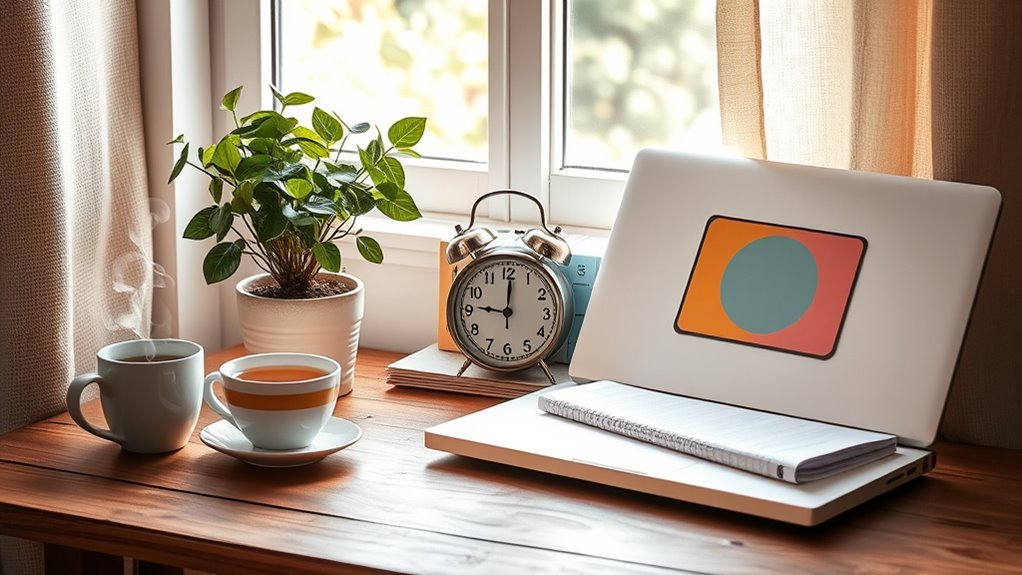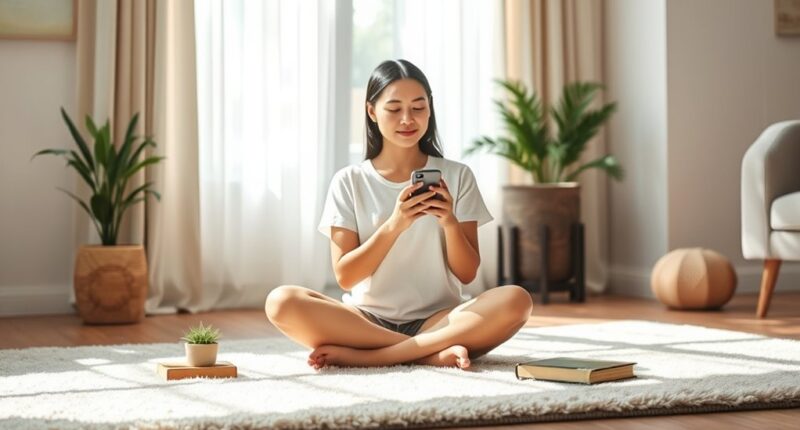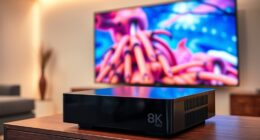To craft healthy screen-time habits that stick, consider combining occasional digital detoxes with a sustainable digital diet. Detoxes give you quick relief and help reset your habits, while a digital diet encourages ongoing mindful use of devices, reducing stress and improving focus. Balancing these approaches can prevent burnout and promote overall well-being. If you want practical tips on creating lasting habits, there are simple strategies to explore next.
Key Takeaways
- Digital detox provides temporary relief and mental clarity, while digital diet promotes sustainable, mindful device use over time.
- Combining short-term detoxes with ongoing digital diets can maximize benefits and prevent rebound effects.
- Setting personalized limits and routines helps craft healthy screen habits that are easier to maintain long-term.
- Incorporating relaxation techniques like essential oils during detoxes enhances stress reduction and relaxation.
- Balancing both approaches supports overall well-being by reducing stress, improving sleep, and fostering healthier digital relationships.

Are you wondering whether to disconnect temporarily or adopt a balanced approach to your digital habits? Making this choice depends on your lifestyle, goals, and how digital devices impact your mental and physical health. A digital detox involves taking a short break from electronic devices, often entirely. It aims to break habitual overuse, reduce dependence, and provide mental clarity. During a detox, you might disconnect from social media, emails, and notifications altogether, which can lead to feelings of relief, decreased stress, and improved mood. However, some people experience temporary loneliness or social disconnection during this period, especially if they rely heavily on digital communication for social interactions. The idea is to create space to reset your relationship with technology, helping you recognize patterns of compulsive checking and develop healthier habits. Incorporating essential oils like lavender or eucalyptus during this time can further support relaxation and mental clarity, aligning with the goal of mental health improvement.
Deciding between a digital detox and a balanced digital diet depends on your lifestyle and health goals.
On the other hand, a digital diet promotes ongoing, mindful control of your digital consumption. It’s a sustainable lifestyle adjustment designed to keep your screen time in check without complete disconnection. Instead of abstaining entirely, you set personalized limits and guidelines to regulate your device use. This approach helps prevent feelings of isolation and keeps you engaged in meaningful offline activities, like hobbies or face-to-face interactions. It encourages a balanced, long-term shift, fostering habits that support mental well-being and focus. A digital diet aims to integrate technology use seamlessly into your life, so it serves you rather than overwhelms you.
Both strategies address the negative effects of excessive screen time, such as stress, anxiety, and digital addiction. Participants in digital detox programs often report relief from mental clutter, experiencing greater clarity and mood stability. Meanwhile, adopting a digital diet can help you maintain these benefits consistently, reducing technostress and improving focus over time. From a behavioral perspective, detoxes heighten awareness of your habits, encouraging you to control notifications and set usage limits. Digital diets, however, promote sustainable change by creating adaptable routines, helping you resist the urge to check devices compulsively. While a detox can be impactful short-term, it might lead to a rebound effect if not complemented by ongoing mindful habits.
In terms of health outcomes, both approaches help improve sleep quality, reduce eye strain, and lower anxiety related to social media. They can also enhance workplace productivity and overall happiness by preventing digital burnout. Scientific research increasingly emphasizes the importance of balanced digital habits, with digital diet emerging as a practical complement to detox strategies. Ultimately, whether you choose a temporary detox or a long-term diet, the goal is to foster healthier, more intentional use of technology—so your digital habits support your well-being rather than undermine it. Recognizing the importance of digital habits and their impact on health can guide you toward more sustainable and mindful technology use.
Frequently Asked Questions
How Can I Balance Screen Time With My Work and Social Life?
To balance your screen time with work and social life, set clear boundaries for work-related use and leisure activities. Prioritize face-to-face interactions and offline hobbies to stay connected. Take scheduled breaks during work to prevent burnout and use digital wellbeing tools to monitor your usage. Incorporate activities like exercise or hobbies that don’t involve screens to create a healthier, more balanced lifestyle.
What Are Some Effective Tools to Monitor My Digital Usage?
Think of your digital usage as a garden needing careful tending. To monitor it effectively, you can use tools like Screen Time on iOS, Digital Wellbeing on Android, and Microsoft Family Safety for all-encompassing device tracking. Third-party apps like RescueTime, Freedom, and Moment help analyze habits and block distractions. For a deeper dive, platforms like Toggl Track and ManicTime offer detailed productivity insights, helping you cultivate healthier screen habits that flourish over time.
How Do I Prevent Digital Fatigue During Long Screen Sessions?
To prevent digital fatigue during long screen sessions, you need to take regular breaks, like following the 20-20-20 rule—look at something 20 feet away for 20 seconds every 20 minutes. Adjust your screen brightness and contrast, sit with proper posture, and keep your screen at eye level. Also, blinking often and using artificial tears can help reduce eye strain, keeping your focus sharp and mind clear.
Can Digital Habits Impact Mental Health Positively or Negatively?
You’re right to ask if digital habits can influence mental health—it’s a double-edged sword. When you use social media mindfully and set boundaries, you can enjoy connection and support. But if you let notifications and comparisons run wild, it can take a toll on your mood and self-esteem. Think of it as taming a wild horse—your habits shape whether digital use lifts you up or drags you down.
How Do I Involve My Family in Creating Healthy Screen Habits?
To involve your family in creating healthy screen habits, start by setting clear rules together, like screen-free zones and designated times. Encourage open discussions about challenges and celebrate progress. Lead by example, showing balanced device use yourself. Plan fun, screen-free activities that everyone enjoys to foster bonding. Using tools like shared logs or apps can keep everyone accountable. This teamwork makes establishing lasting habits easier and more effective for the whole family.
Conclusion
Whether you choose a digital detox or a digital diet, remember that creating healthy screen habits is a journey, not a sprint. Like tending a garden, it takes patience and consistent care to see growth. Stay mindful of your limits, set clear boundaries, and celebrate small wins. By doing so, you’ll nurture a balanced relationship with technology—one that blossoms rather than withers, helping you reclaim your time and peace of mind in this digital age.









